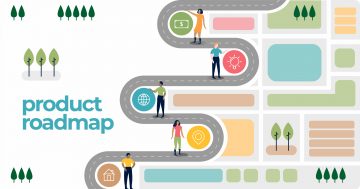How to create a product roadmap visualization?
Published

The human brain processes images 60,000 times faster than text. Nevertheless, many people work and communicate Development teams still using inconsistent, text-heavy programs such as spreadsheets, wikis, and written reports in each meeting.
In the fast-paced world of agile development, communication gaps and delays can lead to costly time loss and inefficiencies.
A product roadmap can help product managers who Communication to streamline and avoid such delays by summarizing and organizing the company's strategy, goals and tasks into easy-to-understand diagrams and process maps.
But what exactly does a roadmap visualization look like?
What is a product roadmap?

Those : venngage.com
A product roadmap helps individuals - or in most cases groups and Teams - to orientate oneself between two points. However, these charts are not physical locations, but represent the evolution of a product or service over time. Behind every product roadmap is the same question: "How do we get our product from where it is now?" to the point where we want it to be in x months?"
The overarching structure of a product roadmap is divided into two parts: At the macro level, a finished diagram is both an overview of the Product strategy as well as a schedule. All other elements of the roadmap fit into this larger framework. (More on the components of a product roadmap in the next section).
Product roadmaps are most effective when they keep everyone involved - from developers to executives and investors - informed. They provide each team with a resource that describes the action plan for developing a product and communicates each team's role within that plan.
Now that we've established its purpose, let's look at an example product roadmap.
The following diagram shows the development of a software product (in this case Lucidchart) over a year. Each swimlane column represents a single quarter, while the rows represent different teams; the product features are inserted into the resulting grid. With just a glance, developers can see not only their team's tasks, but also the timeline for those goals and their respective completion status.
While this chart is aimed at developers, the audience could be broader. A product roadmap can be critical in gaining buy-in from executives or external stakeholders and should be shared accordingly. The more informed and communicative those involved are, the smoother everything will run.
Parts of a roadmap visualization

Those : visme.co
Typically, a roadmap covers a significant period of time (a year or more), breaking down the high-level goals into smaller, more manageable tasks. In an agile environment, this roadmap allows developers to work toward concrete goals and deliver incremental releases, while maintaining the flexibility to adapt to ongoing feedback, changing markets, and other variables.
To illustrate this hierarchy of goals and tasks, the roadmap is divided into several parts.
Stories
Stories are at the granular level of your roadmap. A user story is a development task that aims to achieve a specific goal in the product. It describes the desired outcome for a piece of user functionality within a broader function. In other words, a story illustrates the desired function of a user persona within a product feature.
Describing tasks in terms of the end user's needs helps developers and other stakeholders keep the product vision in mind and focus on the underlying goals of each task.
User stories are usually completed in short sprints. A group of related stories forms an epic.
Epos
An epic is a work consisting of a series of related and interdependent tasks or stories (also called "issues"). They usually extend over a longer period of time (often three or four months) and have a consistent goal.
Initiatives
Initiatives are high-level efforts that often involve the work of teams across the organization. The work is divided into epics with multiple teams and stakeholders contributing.
subjects
At the highest level, visual roadmaps organize tasks under overarching themes. Topics are an easy way to label and categorize tasks within a project, and they often correspond to the company's goals or core values.
By tying your project to targeted themes, your team will understand how their individual tasks relate to the larger goal. Additionally, you can make better decisions about the direction of the product and gain buy-in from key stakeholders more easily - keeping your project on track and on schedule.
Let's say one of your topics is streamlining the ordering process (to reduce the number of abandoned orders). Tasks associated with this topic could include reducing the number of steps in the checkout process (e.g. entering credit card information, creating an account, etc.), simplifying the checkout page, and adding multiple payment options.
However, when presenting the roadmap to other teams, leadership might suggest adding features that aren't entirely consistent with the theme.
For example, the marketing team might want to add a short survey to gain customer insights during the purchasing phase. However, this doesn't fit with your theme of streamlining the ordering process.
Since the topic is clearly outlined in the roadmap, it is easier to say no and justify your decision to those involved. While the survey could provide valuable data about customer behavior and preferences, incorporating it into the purchasing process contradicts one of the project goals: optimizing the purchasing process.
How to create a product roadmap visualization
Each product roadmap visualization will look a little different depending on the needs of the project, but there are certain approaches that will make creating your own a little easier.
When you start creating a product roadmap, structure is crucial. A well-structured roadmap is important to ensure that everyone involved understands the strategy and their roles within the framework. To ensure your roadmap is appropriately structured, work from the top down, from the macro level to the micro level.
1. Create an overarching structure
What is the end goal and when do you want to achieve it? Once you have set a time frame, you can decide how you want to measure the duration of each task, e.g. E.g. in quarters, months, etc. These time units will be the columns of your chart.
2. List of internal stakeholders
Who will be involved in the development of the product? To avoid an overly complex roadmap, list stakeholders by team rather than individually (there may be exceptions). The rows of your chart should correspond to the members of this list.
Refer to this list of stakeholders when breaking down the overall goal into smaller tasks. By dividing the project into strategy- and goal-oriented work (from topics to user stories), everyone involved stays on the same page, so the product stays on track throughout the entire development cycle.
3. Add specific tasks to your roadmap
Once you've established stories, epics, etc., add these smaller elements to your diagram - they should be associated with the appropriate team and span the correct duration.
The finished diagram should look like the product roadmap example you saw earlier in this post.
Tips and tricks for creating a product roadmap

Those : railsware.com
1. Use swimlanes
Swimlanes provide a visual representation of who is responsible for which task and when. They clarify the role of each team throughout the project and improve task handover and communication.
2. Linking to relevant data
As you revise your product roadmap, you should include links to relevant data (e.g. files, documents, content, etc.) wherever possible. In this way, the information is consolidated: those involved do not have to go through a confusing collection documents and files, but can simply look at the product roadmap.
One of the main criticisms for project managers is the interruption of the Communication and information between teams. By making data accessible directly from the roadmap, you can avoid such communication problems. Team members no longer have to dig through folders or contact sheets to find the information they need, reducing communication bottlenecks and increasing efficiency.
3. Use formatting to improve clarity
Formatting your product roadmap can - and should - go beyond visual appeal. For example, you can set up a color code for your roadmap and change the colors of tasks depending on their stage of development. You can also insert icons to indicate the level of completion of a task. This type of formatting allows you to see task progress and team coordination at a glance.
4. Consider the target audience
Before sharing a product roadmap with stakeholders, consider their role in the development of the product. Do they need specific information (release dates, etc.)? As a rule, external stakeholders need less information than, for example, B. the development teams. In general, you should avoid giving external stakeholders specific timelines - otherwise they could tie you to a deadline that you cannot meet.
5. Keep it simple
Of course, if you create your own product roadmap, you can make it as detailed as you want. However, remember that the goal is communication, and when it comes to visuals, sometimes less is more.
A product roadmap is not intended to describe others Project management tools to replace them, but only to supplement them. Your diagram should be an overview; save the details for Jira.








